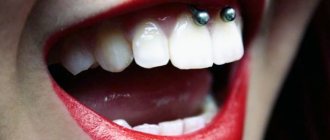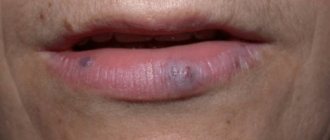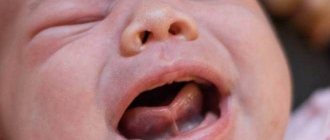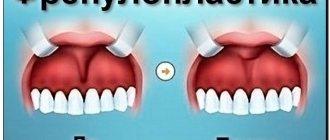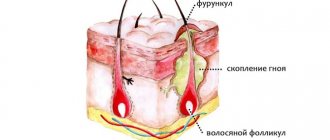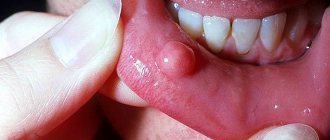Labial frenulum tears are injuries in the mouth. They may cause bleeding but rarely require medical attention.
The labial frenulum is a thin layer of tissue that connects the lips to the gums and bones of the face. There are two different types of labial frenulum:
- the maxillary labial frenulum, which connects the upper lip to the mouth;
- the mandibular labial frenulum, which connects the lower lip to the mouth.
The frenulum of the lips helps keep them in place while the jaw and facial bones grow.
These injuries are usually treated at home, but in some cases medical attention may be required.
First aid for a ruptured upper frenulum
Upper frenulum ruptures are common in children. The main symptom is bleeding from the upper gums and lips.
These injuries rarely require treatment and heal without stitches.
First aid tips for a torn frenulum include:
- Press your outer lip against your teeth for 10 minutes to stop bleeding;
- do not pull out the lip to check the injury, as this may renew the bleeding.
Be sure to check for other signs of swelling or infection after 3 days. After this time there should be no bleeding.
Why are they dangerous?
When the lip moves, the frenulum entails the gum, which moves away from the incisors of the front teeth, thereby causing their increased sensitivity.
As a result, the roots are exposed and periodontal disease occurs. Such manifestations occur, mostly in older people. As for such a disorder in children, the problem is much more serious. Since they are developing a permanent bite and at this time the short frenulum forces the front teeth to move forward, this is more noticeable if there is little meta in the dentition. It should be noted that the consequences of such bites are difficult to correct. In addition, all this will require time and financial costs.
A short frenulum of the upper lip in a newborn child can cause not only serious problems, but also pose a certain danger. With this pathology, the child has difficulty grasping the mother’s nipple, which causes him anxiety, and he quickly experiences fatigue. As a result, he receives less milk than he could have received. Due to fatigue during feeding and incomplete saturation, the baby gains little weight.
The problem also exists in the fact that the reason for such behavior of the child, his physical condition, the mother, and often doctors, see something else - a lack of milk. But it would seem that it would be easier to look into a child’s mouth. Therefore, you need to be aware of this and try to respond more carefully to every change in the child’s behavior.
There are every opportunity to determine the short frenulum in the maternity hospital. It is quite possible that doctors will immediately perform surgical intervention to eliminate frenulum disorders. If at that time it does not interfere with the child’s ability to suckle normally, the correction will be postponed until a later date. Although this may initially affect the child’s pronunciation of individual sounds - he will not be able to pronounce them. In this case, the attending physician will jointly correct the frenulum with a speech therapist.
Can it heal on its own?
Most frenulum tears heal on their own in 3-4 days. Infections or other complications are rare.
While the injury is healing, you can apply a cold compress to it for 20 minutes to relieve pain.
Over-the-counter pain relievers such as Tylenol or ibuprofen are also helpful.
After a frenulum rupture, it is important to stay hydrated. A person should stick to soft foods to avoid chewing and avoid salty, sour or spicy foods. This may irritate the wound.
How to determine
How to recognize any frenulum deviations? What consequences can this pathology have for a child? - such questions are often asked to mothers at a doctor’s appointment.
Identifying a short frenulum in a baby is not difficult even for a non-specialist; it can be seen immediately.
Parents just need to lift the baby’s lip a little and they will be able to see where the frenulum is woven. Compare with the level of the incisor neck. In a normal state, the bridle should be woven slightly above this level - approximately half a centimeter. If the reading is lower, this may directly indicate a short frenulum.
But the final diagnosis, of course, must be made by a doctor. If a pathology is detected, you should contact a medical facility. The consequences of a short frenulum can be found in the list below:
- sucking function is impaired. In most cases, the baby is not able to properly attach to the mother's nipple - to clasp it well and completely;
- changes external data, the face takes on a not entirely aesthetic appearance;
- Tremas are formed, diastemas are gaps located between the front teeth. The latter can be provoked by physiological reasons, for example, this is observed at the stage of development of baby teeth. During this period, the child’s body prepares the jaws for the natural process of replacing teeth with permanent ones. But there are gaps that are caused by pathological reasons - one of which is a short frenulum. In this case, both surgical and orthodontic treatment are recommended;
- be a provoking factor in the manifestation of bite pathology. This occurs as a result of the constant tension of the frenulum causing the incisors to protrude forward. A similar disorder usually occurs in children who already have permanent incisors. The pathology is treated, as in the previous case, with the help of a surgeon and an orthodontist;
- due to the pressure that is constantly exerted on the mucous membrane of the upper jaw, prerequisites are created for the development of inflammatory processes and dental diseases - gingivitis and periodontitis. As a result of the gums exposing the necks of the teeth, they acquire increased sensitivity, which opens the way for caries.
Complications
If the labial frenulum is torn, there is a risk of infection. However, a doctor can easily treat these infections.
A labial frenulum tear is unlikely to cause serious complications. However, people with abnormal labial frenulum structure may experience:
- receding gums around teeth;
- large gap between the upper front teeth;
- Difficulty moving lips.
The surgeon can correct these problems through medical procedures, including frenulum removal.
Consequences of a shortened frenulum
If you lift the upper or lower lip, you will see an elastic fold connecting the latter to the gum. Normally, it is located in the middle of the gum. The shortened one starts from the roots of the teeth. It happens that it is too wide and inelastic, absent, and the frenulum often ruptures.
All these pathologies are indications for surgical intervention. Parents, as a rule, do not pay attention to this anomaly. The mobility and elasticity of this fold can only be assessed by a dentist.
Consequences of rupture of a shortened frenulum
- Difficulty with breastfeeding. The baby will not be able to latch onto the nipple normally. Feeding will be delayed, he will get tired and begin to be capricious. It is quite possible that the child will refuse the breast in favor of the pacifier, since drinking from it is much easier;
- Chewing will become difficult when feeding solid foods. Therefore, he will swallow large pieces, which will negatively affect digestion;
- A short one will stretch the gums, which will affect the dentition - the front incisors will not close, and there will be a gap between them. This will negatively affect your smile later;
- If you do not take action in the presence of milk teeth, then when permanent teeth appear, an incorrect bite will form. The front incisors will protrude forward as the gums are stretched excessively. To correct pathology of the upper or lower jaw, long-term treatment will be required;
- Speech defects due to too much tension on the lip. Lip sounds will sound bad (ooh);
- Inflammatory diseases of the oral cavity. Even with a toothbrush, it will be impossible to properly clean the upper gum, so the incidence of caries, periodontitis, and gingivitis increases.
The main problem hidden behind a short frenulum is inflammatory diseases. A pathologically placed fold pulls on the gum, so the gum, in turn, exposes the roots of the teeth. This applies to pathology of both the upper and lower jaw. Unprotected roots are susceptible to various infections. In addition, an incorrect bite with a shortened lower frenulum causes the jaw to move forward.
Treatment of a ruptured frenulum
The main method is surgery, namely laser plastic surgery. It can be performed according to doctor’s indications as early as the third month of life. Children tolerate such operations better than adults.
In addition, they have a significantly shorter postoperative period.
In addition, you can prevent accidental rupture of the frenulum, which, it is worth noting, happens quite often after an unsuccessful fall, brushing teeth, etc. If the baby needs to have braces or a plate, then the operation is performed before they are installed.
If a problem arises at an older age, surgical intervention is also resorted to.
What methods are used for treatment?
The operation is performed in a clinical setting. It can be performed with a regular scalpel or a laser beam. The latter method is more preferable, since there is no blood, the operation is more sterile, and there is no pain. However, the use of laser is not possible in all cases. If surgery is performed with a scalpel, local anesthesia is required.
The entire procedure lasts about 30 minutes. Finally, sutures are placed at the incision site. The swelling after it lasts about 6 hours, but can last for several days.
A decrease in swelling can be easily determined by the way the baby sucks at the breast: when the condition of the tissues normalizes, he grips tighter and sucks longer.
It often happens that the child cuts his own frenulum. As a rule, this happens when you fall with a toy in your mouth. This is always accompanied by bleeding and hematoma. Treatment of frenulum rupture is contraindicated at home. You need to see a doctor, as it is likely that you will have to put stitches or have the frenulum excised (frenectomy).
What to do after surgical rupture of the frenulum
The postoperative period lasts about a week. Sutures do not require removal, as special self-absorbable threads are now used. After the operation, a child of preschool and school age can visit an educational institution the very next day.
As a rule, a day after surgery it is necessary to undergo a check with a surgeon. For two days you should not eat hot dishes or rough food. If the frenulum was torn accidentally, but the doctor applied stitches or performed an excision procedure, then all subsequent measures also need to be performed. A week later, parents should begin performing special classes - myogymnastics. This kind of exercise helps strengthen the muscles of the mouth and speed up recovery.
When to see a doctor?
Most people can treat a frenulum tear at home. However, in some situations a doctor may be required.
A person should see a doctor within 24 hours if the injury appears infected but there is no fever.
You should consult a doctor immediately if the following symptoms appear:
- a deep tear that may require stitches;
- severe pain that lasts for several hours;
- difficulty swallowing liquids, including saliva;
- problems with fully opening or closing the mouth;
- increased pain or swelling after 48 hours;
- heat.
If you find an error, please select a piece of text and press Ctrl+Enter.
Reasons for the formation of a short or too long frenulum
The frenulum of the upper lip is a soft and elastic fold that can be found when the lip is pulled back (located vertically, coming from the gum). The bridle at the bottom is located similarly. Normally, it is almost invisible, located in the middle of the dentition 5-8 mm above (below) the neck of the teeth. When properly sized, this fold does not cause problems with articulation, eating, or imperfections in the facial area around the mouth. Photos will allow you to independently identify the presence of pathology and contact a dentist.
In general, the causes of fold development anomalies are not fully understood. In almost 50% of cases, a short, deformed or wide frenulum is inherited from one of the parents. Other cases are associated with harmful effects on the fetus in the 1st trimester of pregnancy:
- severe toxicosis;
- taking antibiotics;
- viral diseases;
- the effect of varnish, paint and other chemicals.
Short frenulum of the upper lip in a newborn: etiology and pathogenesis
The reason for the appearance of this feature in a newborn is a violation of the formation of the mucous membranes of the mouth and congenital anatomical anomalies of the oral cavity. The etiology of this defect is determined by various hereditary and external risk factors during the first trimester of pregnancy, when the embryo develops the facial skeleton and oral cavity.
Lip frenulums are thin triangular mucous bridges located vertically between the middle of the lip and the middle of the gum (alveolar process of the jaw). These movable thin bridges serve as limiters for lip mobility.
Most often, the pathogenesis of the defect is caused by the fact that the connection of the frenulum with the gum occurs below the base of the gingival papilla, that is, too close to the teeth. There are also various types of defects in the shape of the bridle itself - compaction, thickening, curvature of the shape, shortening of the free side. These defects lead to the fact that the upper lip becomes inactive, does not completely cover the upper row of teeth, and the patient experiences difficulty closing the lips.
When should the bridle not be trimmed?
Most doctors agree that the short frenulum of the upper lip cannot be trimmed earlier than at the age of 5-6 years. After baby teeth fall out, you need to carefully monitor the growth of your front incisors and work with your doctor to determine whether surgery is really necessary.
Well-known pediatrician Evgeniy Olegovich Komarovsky notes that if your child really has a shortened frenulum of the upper lip, but it does not cause problems (difficulties in feeding, a large aesthetic defect, problems with speech), the operation is not worth doing. If a mother simply does not like the way her child’s upper lip frenulum looks, this is not at all a reason for surgical intervention.
Main contraindications to the operation:
- Caries with complications;
- Diseases of the oral mucous membranes;
- Osteomyelitis is an infectious inflammation of bone tissue;
- Cerebral lesions;
- Blood diseases;
- Oncological diseases;
- Exacerbation of chronic diseases;
- Mental problems.
Whether or not to operate on a shortened frenulum of the upper lip - only a competent doctor can answer this question based on the individual characteristics of your baby. Do not worry ahead of time and do not needlessly perform unnecessary operations on your child if there is no urgent need for it. Remember that a shortened frenulum is not a disease, but just a feature.
When to prune
At what age should a short frenulum be corrected? Is the operation difficult? – such questions often arise from mothers who are faced with this problem. Indeed, it can only be solved surgically. True, there are also difficulties here. It is not always possible to carry out such an operation; certain conditions are required for this.
Trimming the frenulum of the upper lip in children is recommended only when the child’s permanent teeth, or rather the front incisors, begin to emerge. Sometimes such a correction is allowed after the canines or incisors located on the side have erupted. An operation performed during this period will avoid orthodontic treatment. This becomes possible because at the moment of eruption of other teeth it provides the necessary pressure and diastema, three capable of closing themselves.
In the case where the frenulum is treated after the canines and incisors have erupted, it is necessary to use a mechanical clamp of the incisors. Special ties are used for this procedure. They should be placed on the teeth for a short period of time. According to experts, with an integrated approach, the result will be positive.
All these restriction measures are related to the fact that as the jaw grows, the frenulum also changes. An exception to this rule can only be made in the maternity hospital, as mentioned above, when the frenulum really poses a threat to the normal development of the child, he cannot attach well to the mother’s breast. In other cases, you should adhere to the rules of limitation in order to avoid many negative consequences.
Indications for surgery
No doctor will perform an operation without special indications, especially for a child. Surgical correction of the upper lip frenulum is performed if:
- The patient has developed a very wide gap between the front incisors, which is gradually increasing. This leads to displacement of teeth forward and to the sides, contributing to the development of inflammatory processes.
- In preparation for the installation of braces or plates to correct the bite. A short frenulum, creating additional stress on the dentition, will interfere with the alignment of the bite;
- Gum recession is when the roots of the teeth become exposed. This unpleasant phenomenon can lead to various serious inflammatory processes in the oral cavity.
- When planning to wear removable dentures. A shortened frenulum will not allow the dentures to stay firmly on the gums, which will cause a lot of trouble for the patient.
- For serious problems with pronunciation that interfere with the patient’s ability to communicate with other people.
First aid
It is very important to provide first aid correctly:
- The main rule is not to panic. Calm the child and calm yourself, the second is most preferable, because an excited mother can make a lot of mistakes.
- If there is massive bleeding, apply cold (something from the refrigerator) to the lip, but not for long, intermittently.
- After stopping the bleeding, you need to rinse your mouth with any antiseptic (herbal decoctions, Furacilin, Chlorhexidine, Miramistin).
- For children who, due to their age, are not able to rinse their mouths on their own, the mother should treat the wound with a cotton swab dipped in a decoction of herbs. For this, herbs such as St. John's wort, chamomile, and sage are used.
- After all the procedures performed, be sure to visit a doctor. The doctor will conduct an examination, assess the extent of the damage and prescribe further treatment if necessary.
A short frenulum of the upper lip in a child - why is it dangerous and what to do?
The frenulum of the upper lip is the thinnest fold of the oral mucosa that connects the mobile lip to the upper gum. Often mothers notice in their babies that the frenulum is too short or looks unusual.
The situation is aggravated by the fact that different doctors have completely opposite opinions regarding the treatment of this deficiency. What to do, whether to have surgery or not, whether to wait for a certain age for the child or to have surgery right now are the main questions that torment the parents of the baby.
First aid
Providing first aid if an injury occurs will help the damaged tissues recover faster in the future. The very first thing parents should do before the ambulance arrives is to calm the child and calm down themselves. The very first symptom of a rupture or tear is the appearance of blood and pain. If you pull the lip a little, the damaged area is clearly visible. The algorithm for further actions is as follows:
- Wash your hands well with soap and running water. Carefully examine the baby's mouth to determine the location of the bleeding.
- To stop the bleeding, apply a cotton pad or napkin soaked in a solution of hydrogen peroxide, chlorhexidine or miramistin to the surface of the damaged area.
- When the antiseptic treatment is completed, it is necessary to rinse the child’s mouth with boiled water. Do not use tap water. This procedure will help prevent the introduction of microbes into the wound.
- Apply cold compresses to the outside of the lip for three to four minutes. To prevent hypothermia, wrap the ice in a clean towel.
- Carefully ensure that the baby does not touch his face with his hands to avoid infection. Wash your child's hands with soap.
- Be sure to contact your pediatric dentist.
Serious injury requires stitches. Further recommendations from the doctor will help damaged tissues recover faster.
How the adjustment is carried out
Trimming the frenulum of the upper lip is done in a medical facility. Local anesthesia is used for pain relief, and the doctor may even talk to the child during the operation. The duration of the operation, as a rule, during the normal course of the process is about thirty minutes.
There are three options for frenuloplasty:
- dissection. This technique is used when the frenulum of the upper lip is narrow and does not connect to the edge of the alveolar process. The specialist uses experienced manipulations to cut it across, making barely visible longitudinal seams;
- excision. Here, on the contrary, a wide frenulum is visible. The surgeon needs to make an incision that will affect the crest of the tense frenulum, and excise the interdental papilla, as well as the tissue located between the roots of the spread incisors;
- frenuloplasty. This is the name of the method in which the place of attachment of the bridle is changed.
Such operations are almost always carried out with four incisors fully cut. This corresponds to a seven to eight year old child.
During the rehabilitation period, you need to follow some recommendations:
- eat ice cream more often, especially for the first time in the early days;
- observe general hygiene, monitor the condition of the mucous membranes;
- The diet should not contain solid and rough food.
After the correction, sutures will be placed; they are made of a special material that can dissolve on its own. A distinctive feature of this operation is that recovery requires only a few hours.
If the operation was performed on a baby, you can immediately feel the result - the baby will begin to pronounce individual sounds more clearly and apply himself correctly to the mother’s breast.
It should be noted that in recent years, performing operations with sutures has increasingly become a thing of the past, as the usual scalpel is being replaced by a laser one. The recovery period is also shortened, so this technique is primarily indicated for infants for whom breastfeeding is important.
The use of modern methods allows you to avoid even minor complications, such as swelling. During the rehabilitation period, the baby only needs to strictly follow the doctor’s recommendations and exercises for training the frenulum. And everything will work out as if nothing had happened.
